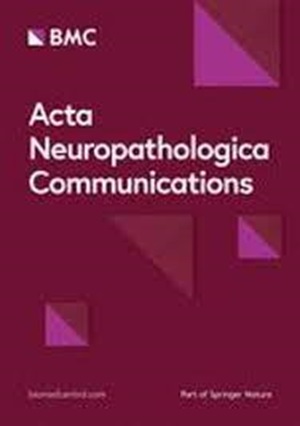水提取的非纤维状阿尔茨海默病 tau 种子和 sarkosyl 提取的纤维状阿尔茨海默病 tau 种子具有不同的特性
IF 6.2
2区 医学
Q1 NEUROSCIENCES
引用次数: 0
摘要
进行性核上性麻痹、额颞叶痴呆、慢性创伤性脑病和阿尔茨海默病的病理tau纤维都有独特的构象和翻译后修饰,与独特的疾病特征相关。然而,在阿尔茨海默病(AD)中,纤维状(鲨基不溶性(AD SARK tau))和非纤维状(水提取高分子量(AD HMW tau))制剂都被认为具有种子能力。我们现在来探讨这些制剂在体内播种特性方面是相似还是不同。我们利用体内扩增和时间历程范例证明,对于 AD HMW 和 AD SARK tau 物种,扩增材料在生化方面与原始样本相似。HMW 和 SARK 材料还显示出不同的清除、传播动力学和传播模式。这些数据表明,在同一个AD大脑中竟然同时存在多种不同的tau,支持了多种tau构象(包括纤维和非纤维)会影响AD表型的观点。本文章由计算机程序翻译,如有差异,请以英文原文为准。
Aqueous extractable nonfibrillar and sarkosyl extractable fibrillar Alzheimer’s disease tau seeds have distinct properties
Pathological tau fibrils in progressive supranuclear palsy, frontotemporal dementia, chronic traumatic encephalopathy, and Alzheimer’s disease each have unique conformations, and post-translational modifications that correlate with unique disease characteristics. However, within Alzheimer’s disease (AD), both fibrillar (sarkosyl insoluble (AD SARK tau)), and nonfibrillar (aqueous extractable high molecular weight (AD HMW tau)) preparations have been suggested to be seed-competent. We now explore if these preparations are similar or distinct in their in vivo seeding characteristics. Using an in vivo amplification and time-course paradigm we demonstrate that, for AD HMW and AD SARK tau species, the amplified material is biochemically similar to the original sample. The HMW and SARK materials also show different clearance, propagation kinetics, and propagation patterns. These data indicate the surprising co-occurrence of multiple distinct tau species within the same AD brain, supporting the idea that multiple tau conformers – both fibrillar and nonfibrillar- can impact phenotype in AD.
求助全文
通过发布文献求助,成功后即可免费获取论文全文。
去求助
来源期刊

Acta Neuropathologica Communications
Medicine-Pathology and Forensic Medicine
CiteScore
11.20
自引率
2.80%
发文量
162
审稿时长
8 weeks
期刊介绍:
"Acta Neuropathologica Communications (ANC)" is a peer-reviewed journal that specializes in the rapid publication of research articles focused on the mechanisms underlying neurological diseases. The journal emphasizes the use of molecular, cellular, and morphological techniques applied to experimental or human tissues to investigate the pathogenesis of neurological disorders.
ANC is committed to a fast-track publication process, aiming to publish accepted manuscripts within two months of submission. This expedited timeline is designed to ensure that the latest findings in neuroscience and pathology are disseminated quickly to the scientific community, fostering rapid advancements in the field of neurology and neuroscience. The journal's focus on cutting-edge research and its swift publication schedule make it a valuable resource for researchers, clinicians, and other professionals interested in the study and treatment of neurological conditions.
 求助内容:
求助内容: 应助结果提醒方式:
应助结果提醒方式:


